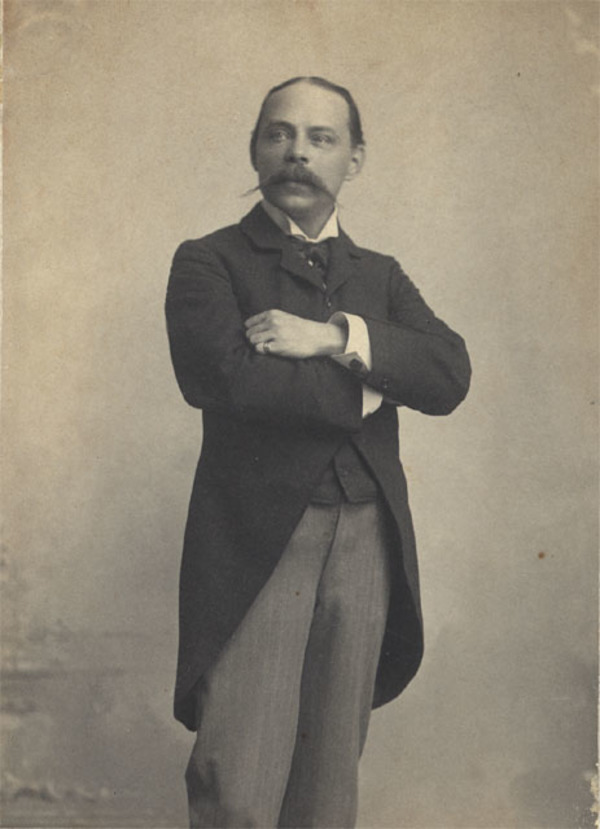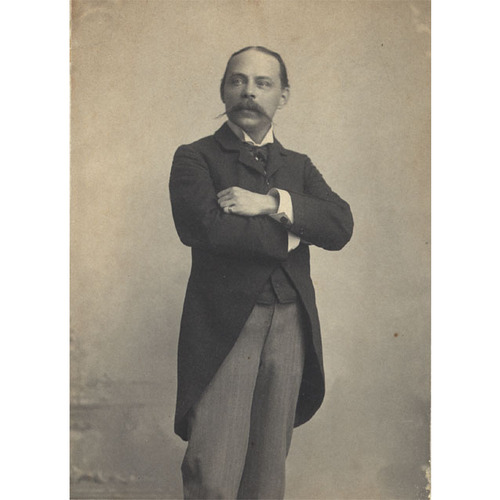
Source: Courtesy of Wikimedia Commons
LE VASSEUR, NAZAIRE (baptized Louis-Nazaire-Zéphirin), journalist, office holder, soldier, musician, and writer; b. 6 Feb. 1848 at Quebec, son of Zéphirin Levasseur and Madeleine Langevin; m. there 5 June 1872 Phédora Venner, and they had four children, including Irma*, the first French Canadian woman physician in the province of Quebec; d. 8 Nov. 1927 at Quebec.
Nazaire Le Vasseur grew up in a business world in which, as he would later recall in his Réminiscences d’antan, hospitality was “open-ended and bountiful” and cultivation of the arts was encouraged. His father, who was at that time manager of a shipyard, was an amateur musician, and the family home was “a meeting place for intellectuals” where many leading figures of the day gathered. They included merchant Abraham Hamel, brother of painter Théophile Hamel*, the family of notary Louis-Édouard Glackmeyer*, pianist Charles Sabatier [Wugk*], and French composer and organist Marie-Hippolyte-Antoine Dessane*. The eldest of three children, Le Vasseur began to take music lessons with Dessane by the time he was five, and over the years he would study piano, cello, violin, flute, and organ.
After completing classical studies undertaken at the Petit Séminaire de Québec from 1857 to 1866, Le Vasseur enrolled in the faculty of medicine at the Université Laval, but after three years, as he himself indicated, his family’s financial difficulties obliged him to withdraw (although his name is not on the list of students enrolled for 1868–69). He then joined the staff of L’Événement, a newspaper recently founded by Hector Fabre*, on which he worked in succession as chief reporter, assistant editor, and finally editor until 1878. As a journalist, he came in contact with many leading political figures, to whom he gave advice or support in electoral campaigns, as he did for Wilfrid Laurier* in 1877. Le Vasseur’s marriage in 1872 to the daughter of a banker had confirmed his social success.
On 2 Oct. 1878 Le Vasseur became a gas and gas meter inspector for the federal government, a position he was to hold until 1915. At the same time he maintained his interest in journalism. In April 1883 he founded an evening newspaper, La Presse, but publication ceased after the first issue because of inadequate funding. Eleven years later, he and Émile La Salle launched La Revue commerciale, a paper quickly replaced in August 1894 by La Semaine commerciale, in which Le Vasseur would continue to publish articles until 1904. He was also a regular contributor to L’Événement. Despite all these activities, he found time to enlist as a militiaman in the 9th Battalion Volunteer Militia Rifles; he took part in the 1885 North-West expedition against Louis Riel*’s Métis, which earned him promotion to the rank of major on his return. Between 1898 and 1913 he was the consul in Quebec for several Central and South American countries, including Nicaragua, Guatemala, Brazil, and Chile.
In 1877 Le Vasseur had been one of the founding members of the Geographical Society of Quebec. Known for his “insatiable intellectual curiosity,” as the Bulletin of the society put it, he published nearly 50 articles between 1883 and 1921 on topics as diverse as Lake Winnipeg, the Mackenzie River basin, Halley’s comet, and Russia. He served as the society’s assistant recording secretary in 1880 and subsequently as vice-president in 1889, honorary president in 1896 (“in recognition of services rendered to the society”), and president from 1898 to 1905. By 1895 he was closely connected with Captain Joseph-Elzéar Bernier*; through the Geographical Society and by organizing fund-raising campaigns, he would help Bernier carry out his expeditions to the North Pole between 1904 and 1911. In 1893 Le Vasseur was also one of the founding members of the Cercle des Dix, a Quebec society which included writers, musicians, and journalists such as Napoléon Legendre*, Narcisse-Henri-Édouard Faucher* de Saint-Maurice, and James MacPherson Le Moine*.
Le Vasseur also took part in the musical life of Quebec. He succeeded his teacher Dessane as organist of Saint-Roch, from 1873 to 1881; together, they had founded the Société Musicale Sainte-Cécile of the church of Saint-Roch in 1869. As conductor of this choir from 1873 to 1885, Le Vasseur performed masses by Haydn, Rossini, and Gounod, as well as Félicien David’s opera La perle du Brésil; Le Vasseur’s wife, who was a singer, was a soloist in some of these concerts. He was secretary of the Quebec Harmonic Society in 1870, and the following year he was co-founder and violinist of the Septuor Haydn, which in 1903 formed the nucleus of the Société Symphonique de Québec (the future Quebec Symphony Orchestra) [see Joseph Vézina]; Le Vasseur played the double bass in this new orchestra between 1903 and 1907. When he died, his fellow musicians, at one of their meetings, would lament the passing of a “pioneer worker who has contributed so much to the success of the society.” In 1880 he succeeded Calixa Lavallée* as director of a choir known as the Quatuor Vocal de Québec and in the same year he was secretary of the organizing committee for the Saint-Jean-Baptiste celebrations in Quebec, during which “O Canada” was given its first performance. In 1887 Le Vasseur was named a member of the Académie de Musique de Québec, which aimed principally to foster interest in music and better regulate musical education; he thus made a mark in the leading musical organizations of the province of Québec.
Despite badly failing eyesight from 1908, Le Vasseur – “with two pairs of glasses on his nose,” as Edmond Chassé, news editor of L’Événement, noted – continued to write for the Bulletin of the Geographical Society of Quebec. He had been thinking since 1881 of undertaking a history of music in Quebec; between 1919 and 1922 this project took form in a series of some 40 articles published in the journal La Musique. Although they contain a number of gaps and errors, as musicologist Vivianne Émond has pointed out, these essays, which were enlivened by personal reminiscences, served for many years as a primary reference source for historians of music in Quebec, particularly with regard to the 19th century. In 1925 Le Vasseur wrote the biography of his friend Ferdinand-Philéas Canac-Marquis, in which, however, anecdotes about the surgeon’s life and his travels figure more prominently than his contributions to science. Two other books, Têtes et figures and Réminiscences d’antan, published in 1920 and 1926 respectively, show that Le Vasseur had a fine sense of style and a gift for storytelling; in the case of Têtes et figures, vivid imagination and knowledge of French Canadian customs are skilfully blended.
Nazaire Le Vasseur died in an unpretentious boarding house in old Quebec. His funeral, held with due solemnity in the basilica of Notre-Dame, was attended by many dignitaries, magistrates, soldiers, and musicians, marking the prestige and influence enjoyed by this passionate and sympathetic scholar. For almost half a century, he had been omnipresent in the cultural, social, and political life of Quebec. A man of wide culture and great intellectual curiosity, a gifted writer, he served on many a committee, founded or co-founded numerous associations, and built up a network of friends who shared his tastes and passions. Having lived since childhood in an artistic milieu, he remained active as a musician throughout his life. Although an amateur, through his activities as a performer, historian, and journalist, he helped lay the foundations of musical life in Quebec City, a contribution for which posterity can be grateful.
In addition to his articles in L’Événement, Le Soleil, La Semaine commerciale (Québec), La Musique (Québec), and the Bull. (Québec) of the Soc. de Géographie de Québec, Nazaire Le Vasseur is the author of Honorable Ph.-Aug. Choquette, ancien sénateur, juge de la Cour des sessions de la paix, Québec (Québec, 1920); Têtes et figures (Québec, 1920); Ferdinand-Philéas Canac-Marquis, médecin-chirurgien: esquisse biographique (Québec, 1925); and Réminiscences d’antan; Québec il y a 70 ans ([Québec, 1926]). He collaborated with Narcisse-Henri-Édouard Faucher de Saint-Maurice and Joseph-Étienne-Eugène Marmette on Le Canada et les Basques (Québec, 1879). At the time of his death, he left in manuscript form a translation of Napoléon-Alexandre Comeau’s Life and sport on the north shore of the lower St. Lawrence and gulf (Quebec, 1909); it would be published in Quebec in 1945 as La vie et le sport sur la Côte Nord du bas Saint-Laurent et du golfe, and reprinted in 1983. He also translated The trail of the sword (New York, 1894) by the Canadian Horatio Gilbert George Parker* under the title Femme, ou sabre ([Québec], 1898).
As a composer, Le Vasseur left some salon music and occasional pieces appealing to contemporary tastes, mentioned by Gilles Potvin in Encyclopedia of music in Canada (Kallmann et al.), 748.
ANQ-Q, CE301-S22, 7 févr. 1848, 5 juin 1872; P152. LAC, MG 30, B21. F.-X. Chouinard, “In memoriam: le major Nazaire Le Vasseur,” Soc. de Géographie de Québec, Bull., 21 (1927): 193–200. DOLQ, vol.2. Vivianne Émond, “‘Musique et musiciens à Québec: souvenirs d’un amateur’ de Nazaire LeVasseur (1848–1927): étude critique” (mémoire de m.mus., univ. Laval, 1986). Robert Germain, “Sur tous les claviers . . . Louis-Nazaire Levasseur,” Cap-aux-Diamants (Québec), 5 (1989–90), no.2: 41–44. Christian Morissonneau, La Société de géographie de Québec, 1877–1970 (Québec, 1971), 53–55, 258. Victor Morin, “Les Dix,” Cahiers des Dix, 1 (1936): 22–25.
Cite This Article
Irène Brisson, “LE VASSEUR, NAZAIRE (baptized Louis-Nazaire-Zéphirin),” in Dictionary of Canadian Biography, vol. 15, University of Toronto/Université Laval, 2003–, accessed January 20, 2025, https://www.biographi.ca/en/bio/le_vasseur_nazaire_15E.html.
The citation above shows the format for footnotes and endnotes according to the Chicago manual of style (16th edition). Information to be used in other citation formats:
| Permalink: | https://www.biographi.ca/en/bio/le_vasseur_nazaire_15E.html |
| Author of Article: | Irène Brisson |
| Title of Article: | LE VASSEUR, NAZAIRE (baptized Louis-Nazaire-Zéphirin) |
| Publication Name: | Dictionary of Canadian Biography, vol. 15 |
| Publisher: | University of Toronto/Université Laval |
| Year of revision: | 2005 |
| Access Date: | January 20, 2025 |



